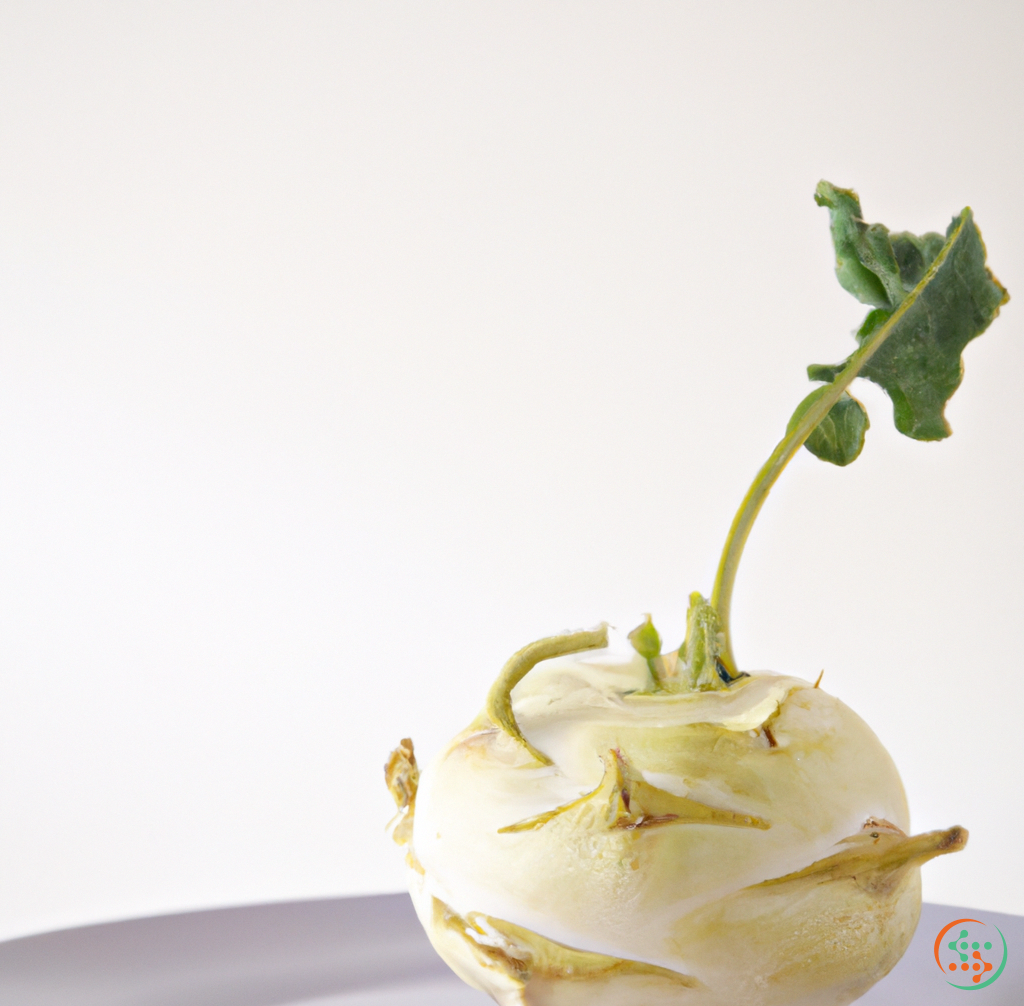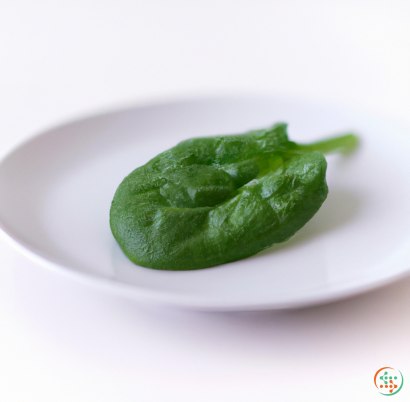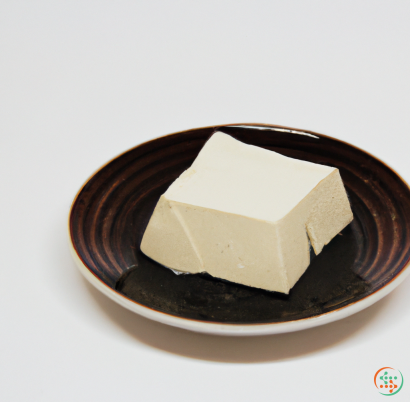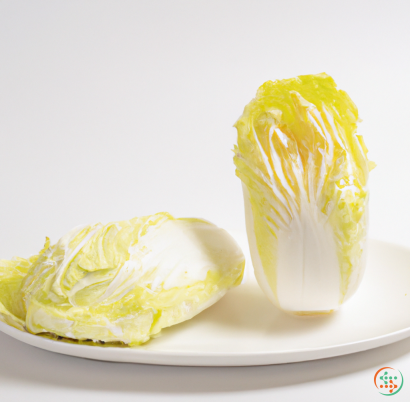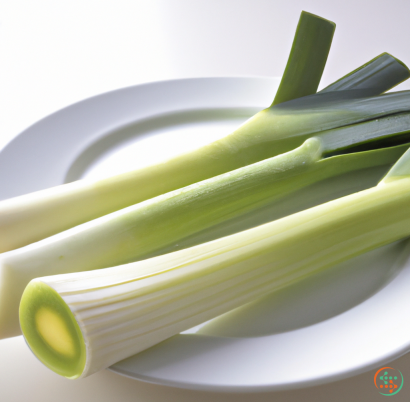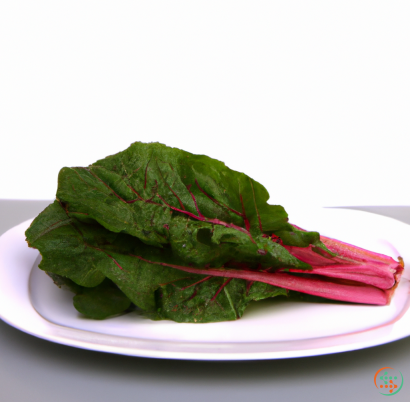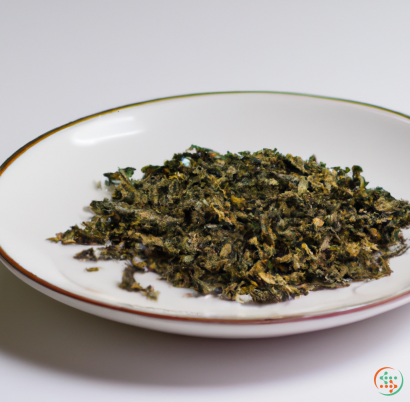Kohlrabi
Kohlrabi, often referred to as both a vegetable and a fruit (it is technically a type of Brassica, a member of the cabbage family), is a nutrient-rich root vegetable that often adds a mild, sweet flavor to dishes. The name “kohlrabi” is actually derived from the German “kohl” for cabbage and the Latin “rava” for turnip, thus giving its full name of “cabbage turnip.” Kohlrabi has been consumed in parts of Europe since the late 1500s, but its popularity has shifted around the world since then as a result of global trade. Today, it grows in temperate climates throughout Europe, North America, Australia, Africa, and South America, and is frequently found in soups, salads, sandwiches, and vegetable side dishes.
What Does a Kohlrabi Look Like?
Kohlrabi’s shape is similar to a large flat onion or a large turnip, with a robust bulb attached at the stem. It’s available in two varieties, purple and green, though the bulb is usually some shade of white. This knobby, thick skinned vegetable is usually fist-sized and ranges from one-and-a-half to as much as four inches in diameter. The stem can grow to be longer than 10 inches and is usually green, but sometimes red or purplish. The leaves can be eaten too, although they are usually not served on their own. Depending on variety or stage of maturity, the leaves can be either tender or tough but flavorful.
Nutritional Value
Although kohlrabi’s flesh is mild in flavor, it is filled with essential vitamins, minerals, and other compounds. A single cup of raw kohlrabi (approximately 116 grams) contains just 35 calories and 3 grams of carbohydrates. This makes it a low-calorie vegetable; an ideal choice for those looking to lose weight.
Kohlrabi also contains plenty of fiber, which helps aid digestion and contributes to a feeling of fullness. It is also rich in vitamins C and B6, potassium and magnesium. Vitamin C plays an important role in skin health and helps to protect your cells from damage. Vitamin B6 is beneficial for neurotransmitter and hormone production. Potassium and magnesium are vital for proper hydration, cardiovascular function, and muscle health.
How to Prepare Kohlrabi
Kohlrabi is a versatile vegetable that can be eaten cooked or raw. The bulb is usually sliced off and used for cooking. Before cooking kohlrabi, be sure to scrub the vegetable and peel the skin off if you don’t like the texture. Try grating raw kohlrabi for a healthy slaw or salad, roasting slices for a crunchy and delicious side dish, or adding cubes to veggie soups, stews, and curries.
Kohlrabi can also be cooked using traditional methods, such as steaming, boiling, or sautéing. When steamed, the vegetable becomes tender and sweet, making it an excellent addition to stews and main dishes. Boiling will soften the vegetable, which makes it a delicious accompaniment to many meals. If sautéed with a little bit of oil and spices, it is transformed into delicious side dish.
No matter how you choose to cook it, you won’t go wrong with kohlrabi. This crunchy, nutrient-filled vegetable is an excellent choice for side dishes, slaws, salads, and curries and is also a flavor-filled and delicious addition to any recipe. As an added bonus, it stores well in the refrigerator for a few weeks, so try stocking up on some when you find it at the store.
Kohlrabi: How a Vegetable Travels From Plant to Plate
In many countries around the world, kohlrabi is a popular vegetable that can be found on dinner tables. Although not as widely known in North America as other veggies, kohlrabi is typically boiled and served with a variety of condiments, sautéed with other vegetables, or added to soups and stews. But what is kohlrabi, exactly, and how does it make its way from the ground to the dinner plate? This article will explore the processes involved in growing and harvesting kohlrabi, from its humble beginnings in the soil to its preparation on a dinner plate.
What is Kohlrabi?
Kohlrabi is a member of the cruciferous vegetable family, closely related to cabbage, kale, cauliflower, and Brussels sprouts. Its texture is firm, crisp, and juicy with a taste similar to a sweet turnip. Kohlrabi’s main edible part is its swollen stem, which provides a mild and sweet flavor. The stem is usually white or purple and its exterior is waxy and highly nutritious.
Kohlrabi, also known as “German turnip” or “turnip cabbage”, is an easy-to-grow vegetable with a long history of cultivation. First developed in the 16th century in Bavaria, it is believed that the name is derived from the Old German words “kohl” (cabbage) and “rabi” (turnip). Although originally grown in Germany, it is now popular in gardens in many parts of the world, primarily due to its ability to tolerate cold winters and its quick maturing time.
The Growing Process
Kohlrabi seeds are sown into the soil during spring or early summer. The soil should be light, fertile, and well-drained with a pH of 6.0-6.5. To ensure optimum growth, the soil should be kept moist and watered regularly as kohlrabi is sensitive to drought. The small seeds are planted in rows approximately two inches apart and lightly covered with soil.
To protect the plant from pests such as aphids, flea beetles, and slugs, gardeners may apply a foliar spray of natural insecticides. Mulching will also help retain moisture and inhibit weed growth, further improving the crop’s chances of success.
Once the seedlings have emerged, the plants require thinning to ensure adequate space for the roots to spread and for the bulbs to expand. After about 60 days, the swollen kohlrabi stems can be identified and harvested.
Harvesting and Storage
Like other root crops, kohlrabi can be easily damaged when harvested. Gardeners have to be careful not to damage the main root or cut the top off. To prevent further damage, kohlrabi should be harvested with a sharp knife, leaving a piece of the stem attached at the base.
Kohlrabi can be harvested when the stems are 2-4 inches in diameter, depending on the variety. If not consumed immediately, kohlrabi can be stored in a cool place, like a root cellar or refrigerator, for up to two weeks.
Preparation
Before kohlrabi can be cooked and served, it needs to be prepared. First, the roots and stems need to be scrubbed to remove any dirt. To remove the tough outer skin, a peeler can be used. Next, the kohlrabi needs to be chopped or sliced into various shapes and sizes, depending on what kind of preparation method will be used.
Common cooking methods for kohlrabi include boiling, steaming, sautéing, roasting, and baking. When boiling, kohlrabi should be cooked until tender (about 10 minutes), and can then be served as a side with butter and seasoning. Steamed kohlrabi has a creamy texture and can be seasoned with herbs, salt, and pepper to bring out its flavor. When sautéed, kohlrabi can be cooked with other vegetables or toasted nuts and served as a vegetable side dish.
Making its Way to the Dinner Plate
Kohlrabi is a versatile and delicious vegetable that can add color and nutrition to any meal. It takes roughly 70–80 days from planting to harvest, but the effort is worth it when kohlrabi finally makes its way to the dinner plate.
Whether boiled in water, steamed, sautéed, or roasted, kohlrabi offers a unique flavor that combines the sweetness of a vegetable with the crunch of a root. In addition, it’s packed with essential vitamins and minerals, making it an excellent choice for a healthy meal.
| Vitamin A | 0.002 mg | |
| Beta-Carotene | 0.022 mg | |
| Vitamin E | 0.48 mg | |
| Vitamin K | 0.1 ug | |
| Vitamin C | 0.062 grams | |
| Vitamin B1 | 0.05 mg | |
| Vitamin B2 | 0.02 mg | |
| Vitamin B3 | 0.4 mg | |
| Vitamin B4 | 0.0123 grams | |
| Vitamin B5 | 0.17 mg | |
| Vitamin B6 | 0.15 mg | |
| Vitamin B9 | 0.016 mg |
| Calcium | 0.024 grams |
Daily Value 1.3 g
|
| Iron | 0.4 mg |
Daily Value 0.018 g
|
| Magnesium | 0.019 grams |
Daily Value 0.4 g
|
| Phosphorus | 0.046 grams |
Daily Value 1.25 g
|
| Potassium | 0.35 grams |
Daily Value 4.7 g
|
| Sodium | 0.02 grams |
Daily Value 2.3 g
|
| Zinc | 0.03 mg |
Daily Value 0.011 g
|
| Copper | 0.13 mg |
Daily Value 0.9 mg
|
| Manganese | 0.14 mg |
Daily Value 0.0023 g
|
| Selenium | 0.7 ug |
Daily Value 0.055 mg
|
| Tryptophan | 0.01 grams | |
| Threonine | 0.049 grams | |
| Isoleucine | 0.078 grams | |
| Leucine | 0.067 grams | |
| Lysine | 0.056 grams | |
| Methionine | 0.013 grams | |
| Cystine | 0.007 grams | |
| Phenylalanine | 0.039 grams | |
| Valine | 0.05 grams | |
| Arginine | 0.105 grams | |
| Histidine | 0.019 grams |
| Total Sugars | 2.6 grams |
per 100g
|
| Palmitic acid (16:0) | 0.01 grams |
|
| Total Saturated fatty acids: | 0.01 g | |
| Oleic acid (18:1) | 0.01 grams |
|
| Total Monounsaturated fatty acids: | 0.01 g | |
| Linolenic acid (18:3) | 0.03 grams |
|
| Linoleic acid (18:2) | 0.02 grams |
|
| Total Polyunsaturated fatty acids: | 0.05 g | |
